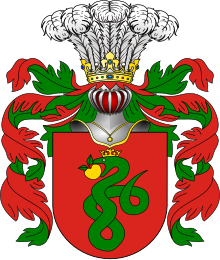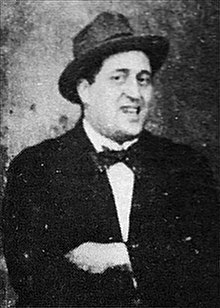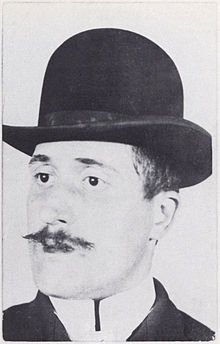Guillaume Apollinaire
From Wikipedia, the free encyclopedia
| Guillaume Apollinaire (Jan Kostrowicki) | |
|---|---|

Photograph of Guillaume Apollinaire in spring 1916 after his shrapnel wound to the temple.
|
|
| Born | Wilhelm Albert Włodzimierz Apolinary Kostrowicki 26 August 1880 Rome, Italy |
| Died | 9 November 1918 (aged 38) Paris, France |
| Occupation | Poet, Writer, Art critic |
|
|
|
| Signature | |
He is considered one of the foremost poets of the early 20th century, as well as one of the forefathers of surrealism. He is credited with coining the word "surrealism", and writing one of the earliest works described as surrealist, the play The Breasts of Tiresias (1917, used as the basis for a 1947 opera).
Two years after being wounded in World War I, he died in the Spanish flu pandemic of 1918 at age 38.
Contents
Life
Wilhelm Albert Włodzimierz Apolinary Kostrowicki was born in Rome, Italy and raised speaking French, Italian and Polish.[1] He emigrated to France in his late teens and adopted the name Guillaume Apollinaire. His mother, born Angelika Kostrowicka, was a Polish noblewoman born near Navahrudak, Grodno Governorate (present-day Belarus). His maternal grandfather was a general in the Russian Imperial Army, killed in the Crimean War. Apollinaire's father is unknown but may have been Francesco Costantino Camillo Flugi d'Aspermont (born 1835-), a Graubünden aristocrat who disappeared early from Apollinaire's life. Francesco Flugi von Aspermont was a descendant of Conradin Flugi d'Aspermont (1787-1874) a poet who wrote in ladin puter (the language spoken in Engiadina ota), and perhaps also of the Minnesänger Oswald von Wolkenstein (born ~1377, died 2 August 1445) [see Les ancêtres Grisons du poète Guillaume Apollinaire, Généanet].Apollinaire eventually moved from Rome to Paris[2] and became one of the most popular members of the artistic community of Paris (both in Montmartre and Montparnasse). His friends and collaborators in that period included Pablo Picasso, Gertrude Stein, Max Jacob, André Salmon, André Breton, André Derain, Faik Konica, Blaise Cendrars, Pierre Reverdy, Alexandra Exter, Jean Cocteau, Erik Satie, Ossip Zadkine, Marc Chagall, Marcel Duchamp and Jean Metzinger. He became romantically involved with Marie Laurencin, who is often identified as his muse.
Late 1909 or early 1910, Metzinger painted a cubist portrait of Apollinaire. In his Vie anecdotique, 16 October 1911, the poet proudly writes: "I am honoured to be the first model of a Cubist painter, Jean Metzinger, for a portrait exhibited in 1910 at the Salon des Indépendants." It was not only the first Cubist portrait, according to Apollinaire, but it was also the first great portrait of the poet exhibited in public, prior to others by Louis Marcoussis, Amedeo Modigliani, Pablo Picasso and Mikhail Larionov.[3]
Apollinaire wrote the preface for the first Cubist exposition outside of Paris; VIII Salon des Indépendants, Brussels, 1911.[4] In an open-handed preface to the catalogue of the Brussels Indépendants show, Apollinaire stated that these 'new painters' accepted the name of Cubists which has been given to them. He described Cubism as a new manifestation and high art [manifestation nouvelle et très élevée de l'art], not a system that constrains talent [non point un système contraignant les talents], and the differences which characterize not only the talents but even the styles of these artists are an obvious proof of this.[5][6]

Jean Metzinger, 1911, Etude pour le portrait de Guillaume Apollinaire, graphite on paper, 48 x 31.2 cm, Musée National d'Art Moderne, Centre Georges Pompidou, Paris
On 7 September 1911, police arrested and jailed him on suspicion of aiding and abetting the theft of the Mona Lisa and a number of Egyptian statuettes from the Louvre,[1] but released him a week later. These thefts were committed by Vincenzo Peruggia, born in Italy, to whom Apollinaire gave shelter, and Apollinaire voluntarily surrendered a number of stolen statuettes left behind by him. Apollinaire implicated his friend Pablo Picasso, who was also brought in for questioning in the theft of Mona Lisa, but he was also exonerated.[7] He once called for the Louvre to be burnt down. Apollinaire was active as a journalist and art critic for Matin, Intransigeant, and Paris Journal.
He fought in World War I and, in 1916, received a serious shrapnel wound to the temple, from which he would never fully recover.[2] He wrote Les Mamelles de Tirésias while recovering from this wound. During this period he coined the word surrealism in the programme notes for Jean Cocteau's and Erik Satie's ballet Parade, first performed on 18 May 1917. He also published an artistic manifesto, L'Esprit nouveau et les poètes. Apollinaire's status as a literary critic is most famous and influential in his recognition of the Marquis de Sade, whose works were for a long time obscure, yet arising in popularity as an influence upon the Dada and Surrealist art movements going on in Montparnasse at the beginning of the twentieth century as, "The freest spirit that ever existed."
The war-weakened Apollinaire died of influenza during the Spanish Flu pandemic of 1918.[2] He was interred in the Père Lachaise Cemetery, Paris.
Works
In 1900 he wrote his first pornographic novel, Mirely, ou le petit trou pas cher, which was eventually lost.[2] Apollinaire's first collection of poetry was L'enchanteur pourrissant (1909), but Alcools (1913) established his reputation. The poems, influenced in part by the Symbolists, juxtapose the old and the new, combining traditional poetic forms with modern imagery. In 1913, Apollinaire published the essay Les Peintres cubistes on the cubist painters, a movement which he helped to define. He also coined the term orphism to describe a tendency towards absolute abstraction in the paintings of Robert Delaunay and others.In 1907, Apollinaire wrote the well-known erotic novel, The Eleven Thousand Rods (Les Onze Mille Verges).[9][10] Officially banned in France until 1970, various printings of it circulated widely for many years. Apollinaire never publicly acknowledged authorship of the novel. Another erotic novel attributed to him was The Exploits of a Young Don Juan (Les exploits d'un jeune Don Juan), in which the 15-year-old hero fathers three children with various members of his entourage, including his aunt.[11][12] Apollinaire's gift to Picasso of the original 1907 manuscript was one of the artist's most prized possessions.[13] The book was made into a movie in 1987.
Shortly after his death, Mercure de France published Calligrammes, a collection of his concrete poetry (poetry in which typography and layout adds to the overall effect), and more orthodox, though still modernist poems informed by Apollinaire's experiences in the First World War and in which he often used the technique of automatic writing.
In his youth Apollinaire lived for a short while in Belgium, mastering the Walloon dialect sufficiently to write poetry through that medium, some of which has survived.
Poetry
- Le bestiaire ou le cortège d’Orphée, 1911
- Alcools, 1913
- Vitam impendere amori', 1917
- Calligrammes, poèmes de la paix et de la guerre 1913-1916, 1918 (published shortly after Apollinaire's death)
- Il y a..., 1925
- Julie ou la rose, 1927
- Ombre de mon amour, poems addressed to Louise de Coligny-Châtillon, 1947
- Poèmes secrets à Madeleine, pirated edition, 1949
- Le Guetteur mélancolique, previously unpublished works, 1952
- Poèmes à Lou, 1955
- Soldes, previously unpublished works, 1985
- Et moi aussi je suis peintre, album of drawings for Calligrammes, from a private collection, published 2006
Prose
- Mirely ou le Petit Trou pas cher, 1900
- "Que faire?",
- Les Onze Mille Verges ou les amours d'un hospodar, 1907
- L'enchanteur pourrissant, 1909
- L'Hérèsiarque et Cie (short story collection), 1910
- Les exploits d’un jeune Don Juan, 1911
- La Rome des Borgia, 1914
- La Fin de Babylone - L'Histoire romanesque 1/3, 1914
- Les Trois Don Juan - L'Histoire romanesque 2/3, 1915
- Le poète assassiné, 1916
- La femme assise, 1920
- Les Épingles (short story collection), 1928
Plays
- Les Mamelles de Tirésias, play, 1917
- La Bréhatine, screenplay (collaboration with André Billy), 1917
- Couleurs du temps, 1918
- Casanova, published 1952
Articles
- Le Théâtre Italien, illustrated encyclopedia, 1910
- Preface, Catalogue of 8th Salon annuel du Cercle d'art Les Indépendants, Musée moderne de Bruxelles, 10 June - 3 July 1911.
- La Vie anecdotique, Chroniques dans Le Mercure de France, 1911-1918
- Pages d'histoire, chronique des grands siècles de France, chronicles, 1912
- Méditations esthétiques. Les peintres cubistes, 1913
- La Peinture moderne, 1913
- L'Antitradition futuriste, manifeste synthèse, 1913
- Jean Metzinger à la Galerie Weill, Chroniques d'art de Guillaume Apollinaire, L'Intransigeant, Paris Journal, 27 May 1914
- Case d'Armons, 1915
- L'esprit nouveau et les poètes, 1918
- Le Flâneur des Deux Rives, chronicles, 1918






No comments:
Post a Comment
Please leave a comment-- or suggestions, particularly of topics and places you'd like to see covered